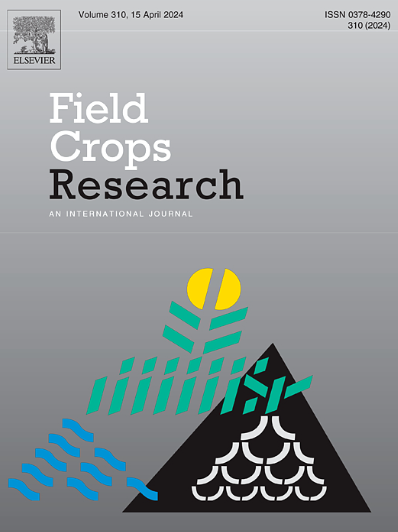A novel, ridged enlarging lateral space drip irrigation pattern (ReDiP) for high- yield and WUE spring wheat in Xinjiang, China
IF 5.6
1区 农林科学
Q1 AGRONOMY
引用次数: 0
Abstract
Context
Drip-irrigated wheat systems typically require more drip tubes, leading to higher costs. We previously developed the enlarging lateral space (ELS) wheat drip irrigation patterns, which reduced drip tube input but resulted in fluctuating yields. Balancing economic benefits with stable yields and water use efficiency (WUE) remains a significant challenge.
Objective
To develop a ridged ELS drip irrigation pattern (ReDip) facilitating water transportation for better grain yield and WUE in wheat, and to decipher the underlying mechanisms in terms of soil water status and plant growth.
Methods
A three-year field experiment was conducted with seven drip irrigation patterns, the conventional pattern (TR4, one drip Tube serves four wheat Rows with row-space of 15 cm and Lateral Spacing of 60 cm), ELS patterns (TR6S (LS = 80 cm) and TR8S (LS = 100 cm), with narrowed row-space of 10 cm and inter-block space of 25 cm), and the ridged ELS patterns (TR6S-R10 and TR8S-R10, with hill angle of 10⁰; TR6S-R15 and TR8S-R15, with hill angle of 15⁰).
Results
In comparison to TR4, TR6S and TR8S separately caused a yield loss of ca. 1.30 % – 10.5 % and 6.82 % – 17.69 %, whilst the corresponding ridged pattern showed much less yield reduction (2.75 % – 7.40 % and −3.32 % – 3.13 % for TR6S-R10 and TR6S-R15, and 8.34 % – 16.09 % and 1.50 % – 14.52 % for TR8S-R10 and TR8S-R15, respectively). Ridging significantly improved horizontal water movement, reducing the coefficient of variation of soil water content and ensuring uniform moisture distribution across the root zone. This was closely related to the better maintained soil water status, which facilitated both root and shoot growth in terms of higher root dry weight and modified canopy structure than the non-ridged patterns. Additionally, ridged patterns mainly improved dry matter accumulation after anthesis and its contribution to grain to increase biomass and harvest index. The optimal pattern, TR6S-R15, achieved 18.91 % – 24.12 % higher in WUE and 0.56 % – 9.11 % higher in profit while maintaining yields comparable to or exceeding TR4 (e.g., 3.32 % higher in 2023).
Conclusions
Ridging facilitates horizontal water movement to maintain better soil moisture status and promotes wheat growth and yield formation. The TR6S-R15 pattern was recommended considering performances of grain yield, WUE and profit.
Implications
The ReDiP system will potentially improve wheat production and WUE in arid regions and be adapted for other crops, offering a sustainable solution for water-saving agriculture.
新疆春小麦高产、高效利用新型垄沟式横向空间滴灌模式研究
滴灌小麦系统通常需要更多的滴管,从而导致更高的成本。我们之前开发了扩大横向空间(ELS)小麦滴灌模式,该模式减少了滴灌管的投入,但导致产量波动。平衡经济效益与稳定产量和水分利用效率(WUE)仍然是一个重大挑战。目的建立一种有利于水分输送、提高小麦产量和水分利用效率的垄沟式滴灌模式,并从土壤水分状况和植物生长等方面探讨其潜在机制。方法采用7种滴灌模式进行3年田间试验,分别为常规滴灌模式(TR4, 1管灌4行,行距15 cm,侧距60 cm)、ELS模式(TR6S (LS = 80 cm)和TR8S (LS = 100 cm),窄行距10 cm,块间距25 cm)和脊状ELS模式(TR6S- r10和TR8S- r10,坡角10⁰;TR6S-R15和TR8S-R15,坡角为15⁰)。ResultsIn TR4相比,分别TR6S和TR8S造成产量损失1.30 % - 10.5 % % - 17.69和6.82 %,而相应的脊模式显示更少的产量减少(2.75 % - 7.40 %和−3.32 % - 3.13 % TR6S-R10和TR6S-R15和8.34 % %和1.50 - 16.09 % - 14.52 % TR8S-R10 TR8S-R15,分别)。垄地显著改善了水平水分运动,降低了土壤含水量变异系数,保证了根区水分分布均匀。这与土壤水分状况保持较好密切相关,根系干重较高,冠层结构优于无垄模式,有利于根和梢的生长。此外,脊状格局主要促进了花后干物质积累及其对籽粒的贡献,提高了生物量和收获指数。最佳模式TR6S-R15的WUE提高了18.91 % - 24.12 %,利润提高了0.56 % - 9.11 %,同时保持了与TR4相当或超过TR4的产量(例如,2023年提高了3.32 %)。结论垄沟有利于水分水平运动,保持土壤水分状态,促进小麦生长和产量形成。综合考虑粮食产量、水分利用效率和经济效益,推荐TR6S-R15模式。该系统将有可能提高干旱地区小麦的产量和水分利用效率,并适用于其他作物,为节水农业提供可持续的解决方案。
本文章由计算机程序翻译,如有差异,请以英文原文为准。
求助全文
约1分钟内获得全文
求助全文
来源期刊

Field Crops Research
农林科学-农艺学
CiteScore
9.60
自引率
12.10%
发文量
307
审稿时长
46 days
期刊介绍:
Field Crops Research is an international journal publishing scientific articles on:
√ experimental and modelling research at field, farm and landscape levels
on temperate and tropical crops and cropping systems,
with a focus on crop ecology and physiology, agronomy, and plant genetics and breeding.
 求助内容:
求助内容: 应助结果提醒方式:
应助结果提醒方式:


